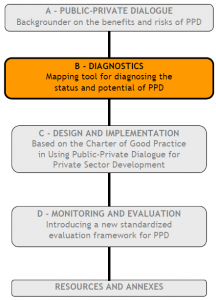Before embarking on designing and implementing a public-private dialogue mechanism, a task manager needs to consider whether there is a need for new initiatives and to what extent existing institutions can be harnessed. The task manager also needs to consider which sectors, topics, or regions possess the greatest need and potential for benefiting from PPD.
Such diagnostic may be conducted differently depending on the project objectives (e.g. establish some overall PPD process on a broad front of issues, making progress on a specific, important and delicate issue, or doing both through a large PPD with a series of working groups). A task manager may invest more into diagnosing a specific sector of the economy, or a specific horizontal issue affecting all firms (e.g. the inspection regime, the tax system or product standards) depending on the nature of the project. In some countries, the business environment may have been diagnosed many times already, where in frontier countries, even basic figures may be missing. The tool presented below should therefore be adapted to the specific local conditions.

